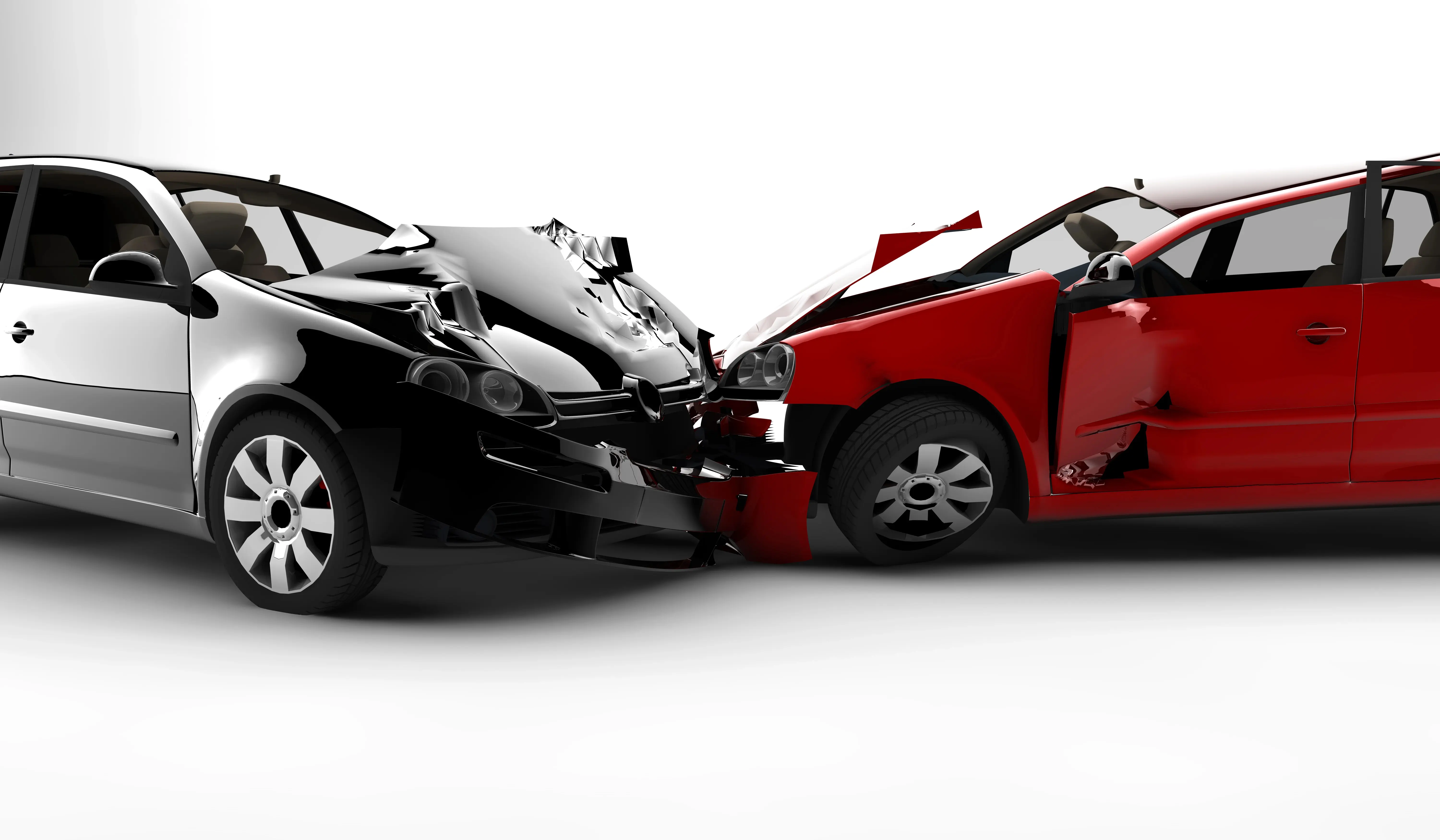Head-on collisions occur when two vehicles driving in opposite directions collide. This type of crash represents roughly 2% of vehicle accidents annually but caused almost 11% of vehicle accident deaths in 2022. Head-on collisions are one of the deadliest types of crashes and the most expensive, with most drivers experiencing a 25% to 35% increase in car insurance premiums after one.
What is a head-on collision?
Also known as frontal collisions or frontal crashes, head-on collisions occur when drivers going in opposite directions crash into each other.
Some of the most common causes of head-on collisions include:
- Speeding.
- Falling asleep at the wheel.
- Driving under the influence.
- Driving in dangerous weather conditions, such as heavy rain or snow.
- Turning the wrong way onto a one-way street.
- Distracted driving, including driving while texting, eating or talking on the phone.
Aside from fatalities, head-on collisions can also result in severe injuries such as whiplash, broken bones, concussions and lacerations.
Car insurance rates generally increase after a serious accident regardless of whether you’re found at fault, but you can generally expect your rates to rise more after an at-fault accident than they would after a no-fault accident.
On average, most drivers experience upwards of a 25% to 35% increase in their car insurance premiums after an at-fault accident.
Here are strategies to help manage the aftermath and mitigate rising costs.
What to do after a head-on car collision
Head-on collisions often cause mental and physical trauma, which can leave you stunned in their wake. While it seems like the options are slim after an accident of this magnitude, you can take control by following these steps.
- Check for injuries and get medical attention: After the crash, assess yourself and any passengers for injuries. Even if you’re not seriously or obviously injured, consider getting a medical exam to treat a common injury like whiplash. You’ll likely be examined by emergency medical services at the scene of the accident, but it’s a good idea to also get a full evaluation afterwards from your doctor.
- Gather evidence: This should include the police report, photographs and videos of the scene, and witness statements and medical records for you and the other passengers involved, if available.
- Contact your insurer: Once you’ve gathered the necessary evidence, reach out to your insurer and start filing a car insurance claim.
- Contact an attorney. Since it’s your responsibility to prove that you’re not at fault for a head-on collision, it’s essential to get legal advice from an experienced car accident attorney. A good personal injury lawyer can help maximize your reimbursement and hire an accident reconstruction specialist to draw up concrete evidence for your case.
How do I know who was at fault in a head-on collision?
Unfortunately, the deadly nature of head-on collisions often means that injured survivors take on the responsibility of proving that the other driver was at fault.
In the case of both parties’ survival, accident fault determination rules state that an insurance adjuster may assign each driver a percentage of the fault. Shared blame for the accident is also known as comparative fault or shared liability.
Here are four ways fault can be determined after a head-on collision.
- Drivers have a duty of care, which includes being attentive, responsible and sober. Distracted driving, driving at high speeds and driving under the influence are all potential causes of head-on collisions.
- If reckless behaviors were observed before the crash, that driver may be proven negligent.
- Establishing that injuries were sustained as a result of a driver’s actions is crucial to assigning fault.
- The driver traveling in the opposite direction of traffic is typically found at fault in a wrong way crash.
Does insurance cover at-fault accidents, even head-on collisions?
Yes, insurance covers at-fault accidents in at-fault states — which most are. In an at-fault state, the driver who caused the accident is financially responsible for damages sustained by the other party, including property damage, medical bills and funeral expenses. Additionally, the victim may choose to sue the at-fault driver for economic hardships that were not covered by the settlement, such as lost wages or pain and suffering.
In a no-fault state, however, drivers turn to their individual insurance companies for financial compensation for medical bills and/or wage loss up to their policies’ limits — regardless of fault. Check with your insurance provider to learn more about your policy and where to turn after a collision.
NEED TO KNOW: If you only have the state-mandated minimum car insurance, you might not be fully covered in the event of a head-on collision. The same is true if you’re found not at fault, but if the at-fault driver only has minimum coverage, that can result in lower payouts than the overall cost of damage.
Full coverage car insurance offers more financial protection — it includes collision and comprehensive coverages — but it may be wise to consider other policies as well.
- Personal injury protection (PIP): Pays for your medical bills even if you were the at-fault driver.
- Uninsured or underinsured motorist (UM/UIM): Helps pay for damage to your car and medical bills if the other driver doesn’t have adequate insurance coverage.
- Guaranteed auto protection (GAP): Covers the difference between your vehicle’s actual cash value (ACV) and the remaining loan balance if your car is deemed a total loss.
Comprehensive vs. collision insurance
Neither comprehensive nor collision insurance is legally required in the U.S., but each can be crucial for protecting your vehicle.
- Collision insurance covers damage to your car when it hits another vehicle, animal or object. This is true whether it’s a head-to-head collision or a fender bender.
- Comprehensive insurance also covers damage to your car caused by events outside of your control, like theft, vandalism, weather (hail or fire, for instance) or damage from a fallen tree.
In either scenario, you must pay a deductible before the insurance company will pay out. Both coverages are often required by lenders if you’re financing or leasing a vehicle.
Best accident forgiveness insurance for high-risk drivers
Unfortunately, no single insurance provider will offer the best coverage for a head-on collision — and providers will likely raise your premiums after this type of accident anyway, regardless of fault. Most insurance companies charge this additional premium for three to five years after an accident.
Additionally, insurance companies use different algorithms to determine rates, so you may see a big variation in quotes from one provider to the next. It’s important to shop around and compare quotes from at least three providers before deciding which insurance company is right for you, but keep in mind that it may be difficult to find affordable insurance after an at-fault accident.
Based on Jerry data, these are the top providers with the lowest average rates for drivers needing minimum coverage with an at-fault accident on their record.
|
Insurance Company
|
Avg Monthly Quote
|
|---|---|
| Aspire Advantage | $111 |
| Bluefire | $115 |
| Aspen | $134 |
| Mercury | $135 |
| Anchor General | $140 |
How to lower insurance rates after an accident
After any kind of accident, you may notice an increase in your car insurance rates. Here are a few ways to lower your premium.
- Shop around: The best way to find the right insurance policy price after a car accident is to shop for quotes from multiple providers to get a sense of what your rates could be.
- Ask about discounts: Many insurance providers offer car insurance discounts for things like taking a defensive driving course or getting good grades. Ask your provider if you’re missing out on any opportunities to save.
- Bundle your policies: For some drivers, bundling home and auto insurance, or auto and renters insurance, is a great way to save money. This type of savings isn’t available everywhere, so talk to your insurer to see if they offer bundling discounts.
- Enroll in a telematics program: With telematics, your insurance company can monitor your driving habits — including when, how well and how often you drive. With this information, insurance companies offer discounts to good drivers and people who don’t drive often. In some cases, you can even get a discount just for signing up.
- Increase your deductible: If all else fails, you can also increase your car insurance deductible to get lower premiums. A higher deductible means lower risk for insurance companies, so your monthly rates will lower as your deductible rises. Just remember that you’ll be responsible for paying your deductible out-of-pocket in the event of an accident, so never raise your deductible higher than you can afford to pay.
FAQ
-
Are head-on collisions likely when driving?
-
Is a head-on collision worse than a rear-end collision?
-
Who is at fault in a head-on collision?

Megan Lee is an editor, writer, and SEO expert who specializes in insurance, personal finance, travel, and healthcare. She has been published in U.S. News & World Report, USA Today and elsewhere, and has spoken at conferences like that of NAFSA: Association of International Educators. Megan has built and directed remote content teams and editorial strategies for several websites, including NerdWallet. When she`s not crafting her next piece of content, Megan adventures around her Midwest home base where she likes to drink cortados, attend theme parties, ride her bike and cook Asian food.

Everett Cook is an award-winning journalist and editor with more than 10 years of experience across a variety of industries. In editing for Jerry, Everett’s mission is to help readers have a better understanding of the costs of owning or leasing a car and to better understand their vehicle in terms of insurance and repairs. Prior to joining Jerry, Everett was an editor for Axios. His previous work has been featured in The New York Times, The Los Angeles Times, The San Francisco Chronicle, The Atlantic, Atlantic Re:think, The Boston Globe, USA Today, and others. He’s also been a freelance writer and editor with experience in SEO, audience building, and long-term content roadmaps. Everett is a proud graduate of the University of Michigan.









